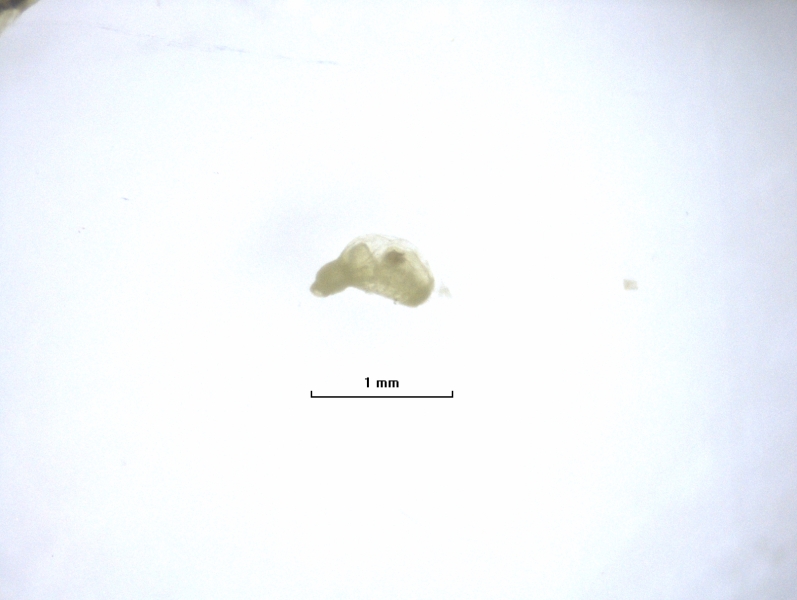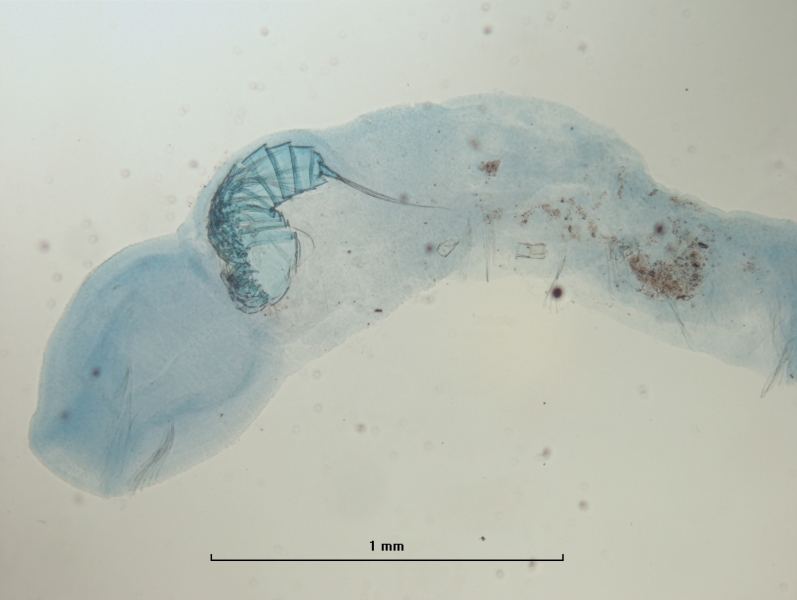Chaetogaster diaphanus
Taxa description
Chaetogaster diaphanus (Gruithuisen, 1828) is a freshwater oligochaete worm that is common in the Great Lakes. It is naidid worm without dorsal chaetae, with a highly modified and enlarged pharynx, a terminal mouth, and a reduced prostomium. There are 6–13 ventral chaetae in II which are between 145–350 μm long, which is quite long compared to other naidid worms. These chaetae are often swept forward toward the mouth opening. There is often a large gap after II for the enlarged pharynx, and III–V are missing chaetae. There are 4–10 chaetae in bundles of VI and posteriad. All chaetae have the upper tooth longer than the lower. The prostomium is truncated and inconspicuous. C. diaphanus is predatory and cannibalistic unlike most other oligochaetes. This species may also include C. cristallinus, which has a small incision in the median of the prostomium and shorter chaetae in II (111–165 μm). Often, the only part of C. diaphanus present is the enlarged pharynx, and the posterior part from VI onward has fragmented.
Distinguishing features
C. diaphanus is unlike most worms in the Great Lakes because of its lack of dorsal chaetae and its truncated anterior end that is mostly lacking a prostomium. The ventral chaetae of II are between 145–350 μm long, III–V are missing chaetae, and the upper tooth of the ventral chaetae is longer than the lower.
Habitat
Lake occurrence
This species occurs in all five Great Lakes.
Similar species
Care must be taken to ensure that full specimens of C. diaphanus are not mistaken for oligochaete fragments due to its truncated anterior that lacks a prostomium. Besides C. cristallinus (described in Taxa description), C. diaphanus is most similar to C. diastrophus, which also lacks dorsal chaetae. However, C. diastrophus has a slightly developed prostomium and the chaetae of II are only 72–110 μm. Rarely, C. diastrophus may have dorsal chaetae starting in VI. The other species of Chaetogaster that have reduced prostomiums are much rarer, such as C. limnaei, which is parasitic or commensal with molluscs and has strongly curved sub-equal teeth, or C. setosus, which has sigmoid simple-pointed chaetae and a much smaller range.
Occasionally, Ophidonais serpentina sheds many or all of the dorsal needles. If there are any dorsal chaetae, it should still be possible to be identified by the solitary, thick, straight needles that are blunt or minutely bifurcate. Otherwise, it can still be distinguished from C. diaphanus because it has a conspicuous prostomium and ventral chaetae in every segment. The other possible naidid worm that might be confused is Haemonais waldvogeli, which usually lacks dorsal chaetae from II–XVIII or XX. If the specimen has fragmented before XX, the ventral chaetae and prostomium must be used to differentiate them. Normally, H. waldvogeli has dorsal bundles with 1 hair and 1 dorsal chaeta with the upper tooth longer than the lower, anterior ventral chaetae are longer and thinner than the rest, and posterior ventral chaetae are more curved and have the upper tooth shorter and thinner than the lower. The dorsal chaetae from II–XVIII do come in but are usually quickly shed. There is no enlarged pharynx, chaetae are present from III–V, ventral chaetae of II are not longer than the rest, and there is a prostomium.
Due to its odd shape, C. diaphanus could also be confused with some species of Turbellaria, especially Hydrolimax grisea, which is ovate, lacks hair chaetae, and often has egg capsules visible inside.
Relative size
C. diaphanus is generally a short, small to medium-sized oligochaete worm similar in size to other naidid worms.
Does it have a barcode reference from the Great Lakes?
Yes, this species does have a barcode reference from the Great Lakes.
References
Kathman, R.D., and R.O. Brinkhurst. 1998. Guide to Freshwater Oligochaetes of North America. pp. 42–43, 32, 50–51, 64–65.
Hiltunen, J.K., and D.J. Klemm. 1980. A Guide to the Naididae (Annelida: Clitellata: Oligochaeta) of North America. pp. 10–11, 33.



